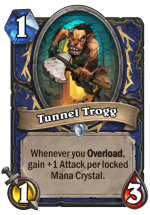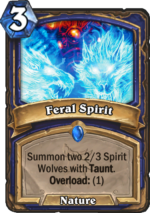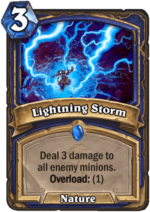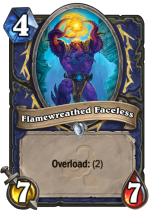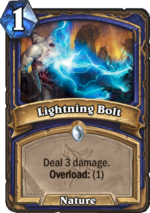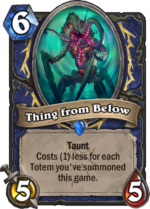Mulligans
General Mulligans
These are the typical minions that will be used to get early board control. The main idea is to trade often and to avoid taking as much damage as possible in the early stages of the game, so that you can later get your heavy hitting AOEs and minions to finish the game. Flamewreath Faceless should only be kept against classes that can't remove it early on, so typically only Druid and Priest. Lighting Bolt can also be kept if you have Tunnel Trogg and expect the enemy to play a 1/3, such as Northshire Cleric or Mana Wyrm. Be aware that you should plan for how Overload will change the pacing of your curve when you mulligan.
Aggro Mulligans
Early minions are important here as taken heavy early damage is the easiest way to lose here, however AOE is likely the most important type of card to keep. Allowing the enemy to feel safe overextending into a heavy board and then wrenching it from his hands with a well placed AOE is almost necessary to winning against Aggro. It may even be worth mulliganing solely for AOE, but I haven't played nearly enough with this deck to say that for sure. In the case that you get a Lighting Storm and an Elemental Destruction then the Elemental Destruction should be gotten rid of. It is a great card, but it's cost is rather heavy and it should typically be used against three or four bigger minions as opposed to several small minions anyway.Midrange Mulligans
The most important aspect of playing against midrange is to get the absolute most value out of every card and every point of mana. Make sure to keep cards that are not only on regular curve, but also on overload curve. Tunnel Trogg into Totem Golem into Coin Tuskarr Totemic is a very good start because that allows you to play Thing From Below on turn 4. This is because Thing From Below has synergy with all summoned Totems not just ones gained from hero power. Flamewreathed Faceless is also a good keep because it is the one of the best 6 drops in the game and can be played on turn 4. Typically it should be used solely for face damage, but in certain situations it is reasonable to trade. Such as trading into an Azure Drake if you expect a powerful spell the next turn.Combo Mulligans
Not sure what to expect from combo decks yet, but you can't go wrong with these standard cards.
Control Mulligans
In this match up it is important to be able to take care of early game control minions that allow them to snowball easily. For this reason, it is good to keep Lightning Bolt and Tunnel Trogg. These allow you to trade with minions such as Northshire Cleric and Armorsmith. Elemental Destruction is also a strong keep because it is highly likely that at some point in the game you will need to remove critical minions from the board and you want to have it in your hand.
This is a deck I built around Hallazeal The Ascended.
It is a largely variant of this Kolento deck (http://www.hearthstonetopdecks.com/decks/kolentos-wotg-standard-midrange-shaman/).
I decided to cut The Black Knight and one elemental destruction is favor of two lightning storms. My first reason for doing this is that I do not actually have The Black Knight. My second and more important reasoning behind this is that, while playing a two elemental destruction version of this deck, I found that I needed to be able to control the board more often because of the appearance of several aggro decks, particularly the councilman warlock.
The main idea behind this deck is to establish early board presence with Totem Golem and Feral Spirit then move on to Thing From Below and Flamewreathed Faceless into using Master of Evolution to evolve damaged minions then Fire Elementals to clean up enemies and Hogger to hold onto the board until you finally get Ragnaros to finish the enemy off.
Hexes, Lightning Storms, Elemental Destruction, and Hammer of Twilight are used to wrench the board out of the enemy’s hands. The best way to do this is to save Hexes for the critical minions in the enemy’s deck, such as C’thun, or to use it to clean up any leftover minions that survive an AOE. The AOEs themselves should be saved until the enemy reaches a critical mass of minions without allowing them to do too much damage to the hero, so that each card has maximum value. Hallazeal can be played strategically during this time to heal up as the total damage done by the AOE will in turn heal your hero. Taking an extra turn of damage then playing Hallazeal and an AOE may be worth it if you think you can survive, but don’t be hesitant to play it as an aggro card and use it’s nice stats to trade though.
Any thoughts or input would be gladly welcomed.


















/rating_1_off.png)
/rating_2_off.png)
